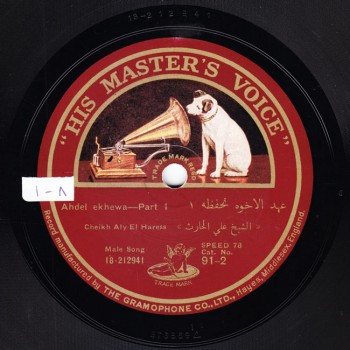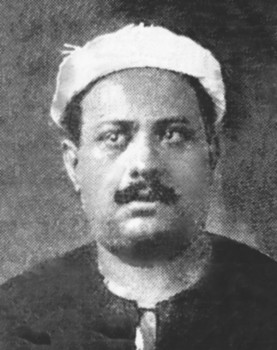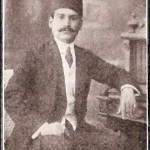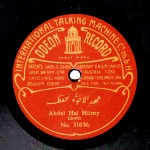 The Arab Music Archiving and Research foundation (AMAR), in collaboration with the Sharjah Art Foundation (SAF), presents “Sama‘ ”.
The Arab Music Archiving and Research foundation (AMAR), in collaboration with the Sharjah Art Foundation (SAF), presents “Sama‘ ”.
“Sama‘ ” discusses our musical heritage through comparison and analysis…
A concept by Mustafa Said.
Dear listeners,
Welcome to a new episode of “Sama‘ ”.
Today we will resume our discussion about dawr “ ‘Ahd el-ukhuwwa” written by Ismā‘īl Bāshā Ṣabrī and composed by ‘Abduh al-Ḥāmūlī.
We had almost finished the madhhab (refrain).
Let us start by listening to a recording of Ṣāliḥ ‘Abd al-Ḥayy… among the last ones, specifically the dakhla (overture) from the madhhab to the dawr (semi-composed metric song)… Because I think he took the lyrics from the live performances and not from any of our recordings of ‘Abd al-Ḥayy Ḥilmī. This dakhla into the dawr, that includes a surprise, is a peek of salṭana and ṭarab (aesthetic emotion triggered by art music and singing).
Let us listen to it …
(♩)
Let us listen to other dakhla-s performed by ‘Abd al-Ḥayy and by Sheikh ‘Alī al-Ḥārith …
(♩)
The difference is minor… It is as if they were singing any other dawr. Yet Ṣāliḥ ‘Abd al-Ḥayy’s dakhla included a surprise that he clearly performed on purpose since he repeated it in both recordings as well as in all the other recordings.
Let us now listen to “ ‘Īd el-bashāyir w-el-faraḥ / lāḥ lī bi-waghak yā amar” and note how each dealt with “yā amar”.
Let us start with ‘Abd al-Ḥayy’s 1905 Odeon recording …
(♩)
Now, his Gramophone recording …
(♩)
Here, the instruments play the role of the biṭāna (chorus), i.e. they answer ‘Abd al-Ḥayy Afandī.
The Baidaphon recording now …
(♩)
Note that Ṣāliḥ ‘Abd al-Ḥayy was inspired by the Baidaphon recording…
(♩)
In both recordings, not only in one…
(♩)
In fact… in all his recordings of this dawr…
Let us listen now to Sheikh ‘Alī al-Ḥārith …
(♩)
He does not bring any changes to the responses. He only performs the tafrīd (improvisation).
Let us now listen to ‘Abd al-Ḥayy’s Odeon recording made in 1903 or in 1904, specifically the end of side 1 and the beginning of side 2 …
(♩)
I think that, in this recording, the disc ended before he had finished: he tried to fit the dawr into one side, but it ended and he had to resume on side 2.
‘Abd al-Ḥayy Ḥilmī is the only one who performed āhāt (free repetition of the word “āh”), tarannum (chanting). Moreover, he only did so in the 30cm Gramophone recording on three sides made in 1908… and in which he took his time.
Let us listen to this part…
(♩)
Beautiful!
This is only performed in this recording… Ṣāliḥ, ‘Alī al-Ḥārith and all the others go directly to the hank (responsorial part of improvisation between the singer and the chorus) and the dialogue with the ensemble.
Let us end today’s episode with the full dawr performed by Sheikh ‘Alī al-Ḥārith.
We have listened to it in the voice of ‘Abd al-Ḥayy Ḥilmī accompanied by Ibrāhīm Sahlūn and Muḥammad Ibrāhīm.
This time we will listen to it performed with a similar takht (ensemble), added to a riqq player, including: Muḥammad al-‘Aqqād, Sāmī al-Shawwā, and Maḥmūd Raḥmī.
Being a Sheikh, not an Afandī, Sheikh ‘Alī al-Ḥārith does not segment the words like ‘Abd al-Ḥayy or the others, as we hinted at in relation to the madhhab.
The manner in which he enters the layālī (sung improvisation on the words yā lēl yā ‘ēn (O night, O eye)) into the madhhab clearly shows that he did not focus on the lyrics of the dawr. He mixes the verses together in the tafrīd in “ ‘Īd el-bashāyir w-el-faraḥ”, and goes directly to “lammā el-ḥasūd” before “lāḥ lī bi-waghak yā amar”. His tafrīd is very focused: he turns side 2 and resumes it with the same focus. He starts the hank in “Mā fish khilāfak ḥadd asma‘ kalāmuh in amar” almost at the end of the dawr then concludes at “min sa‘dinā albuh nfaṭar”… “lammā el-ḥasūd shāf el- minaḥ / min sa‘dinā albuh nfaṭar”… for no obvious reason… he just felt like concluding like this.
This brings us back to the fact that the structure of the dawr is simple, allowing the one singing it to deal with it at whim.
At the same time, its pattern is very clear and taken from the madhhab.
Let us listen to Sheikh ‘Alī al-Ḥārith.
We will meet again in a new episode to resume our discussion about dawr “ ‘Ahd el-ukhuwwa”.
Here is Sheikh ‘Alī al-Ḥārith …
(♩)
“Sama‘ ” was presented to you by AMAR.
- 221 – Zakariyya Ahmed – 12 (1/9/2022)
- 220 – Zakariyya Ahmed – 11 (1/9/2022)
- 219 – Zakariyya Ahmed – 10 (11/25/2021)
- 218 – Zakariyya Ahmed – 9 (10/26/2021)
- 217 – Zakariyya Ahmed – 8 (9/24/2021)
- 216 – Zakariyya Ahmed – 7 (9/4/2021)
- 215 – Zakariyya Ahmed – 6 (8/28/2021)
- 214 – Zakariyya Ahmed – 5 (8/6/2021)
- 213 – Zakariyya Ahmed – 4 (6/26/2021)
- 212 – Zakariyya Ahmed – 3 (5/27/2021)
- 211 – Zakariyya Ahmed – 2 (5/1/2021)
- 210 – Zakariyya Ahmed – 1 (4/28/2021)
- 209 – W-al-Lāhi lā astaṭī‘u ṣaddak 2 (4/6/2017)
- 208 – W-al-Lāhi lā astaṭī‘u ṣaddak 1 (3/30/2017)
- 207 – Bashraf qarah baṭāq 7 (3/23/2017)



